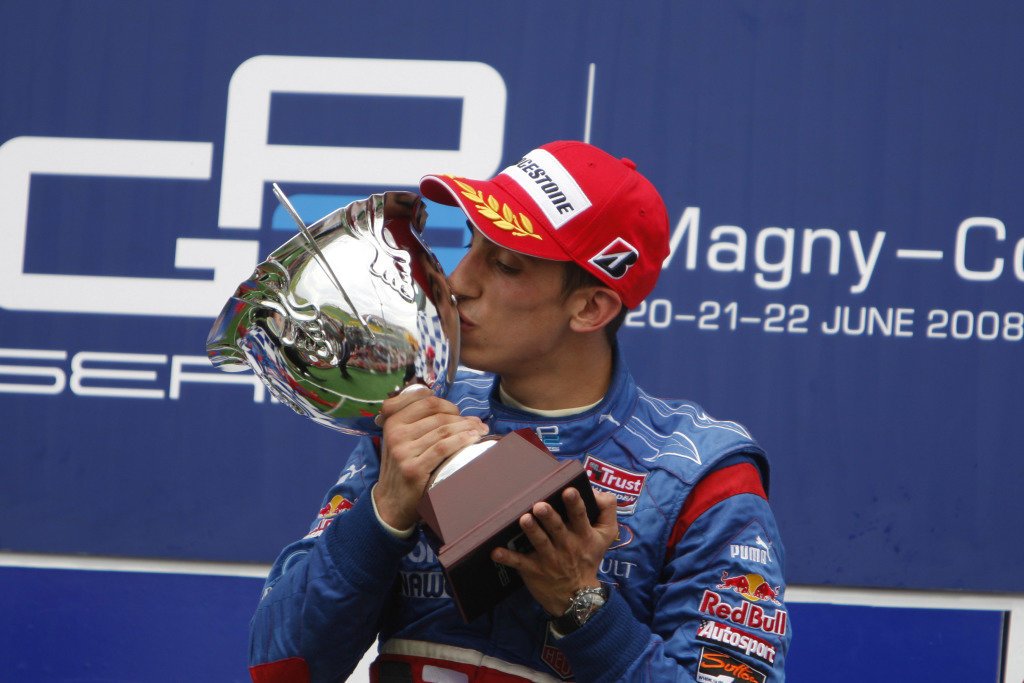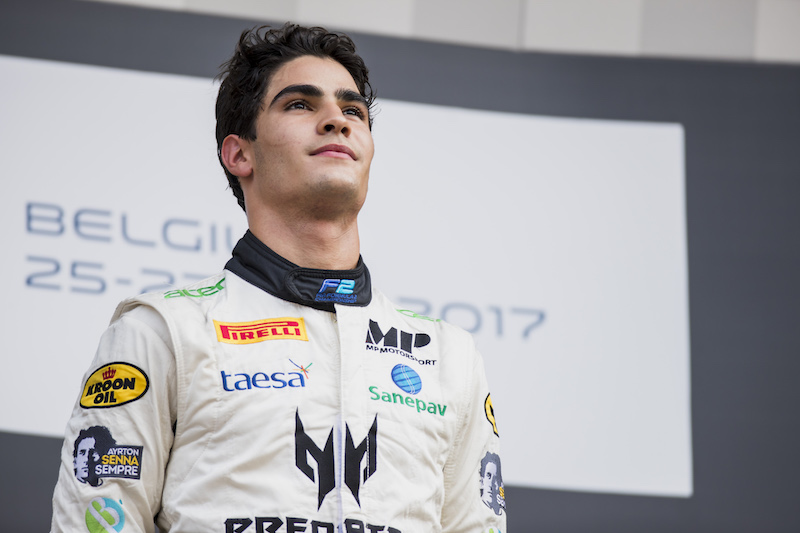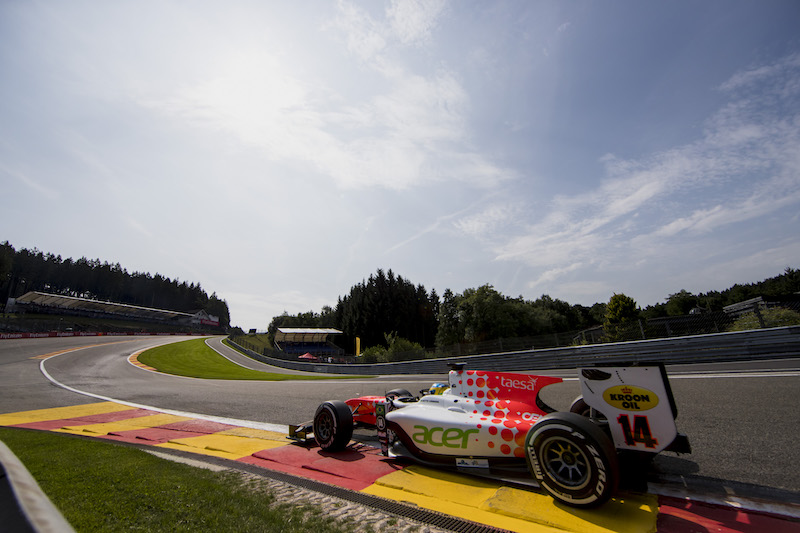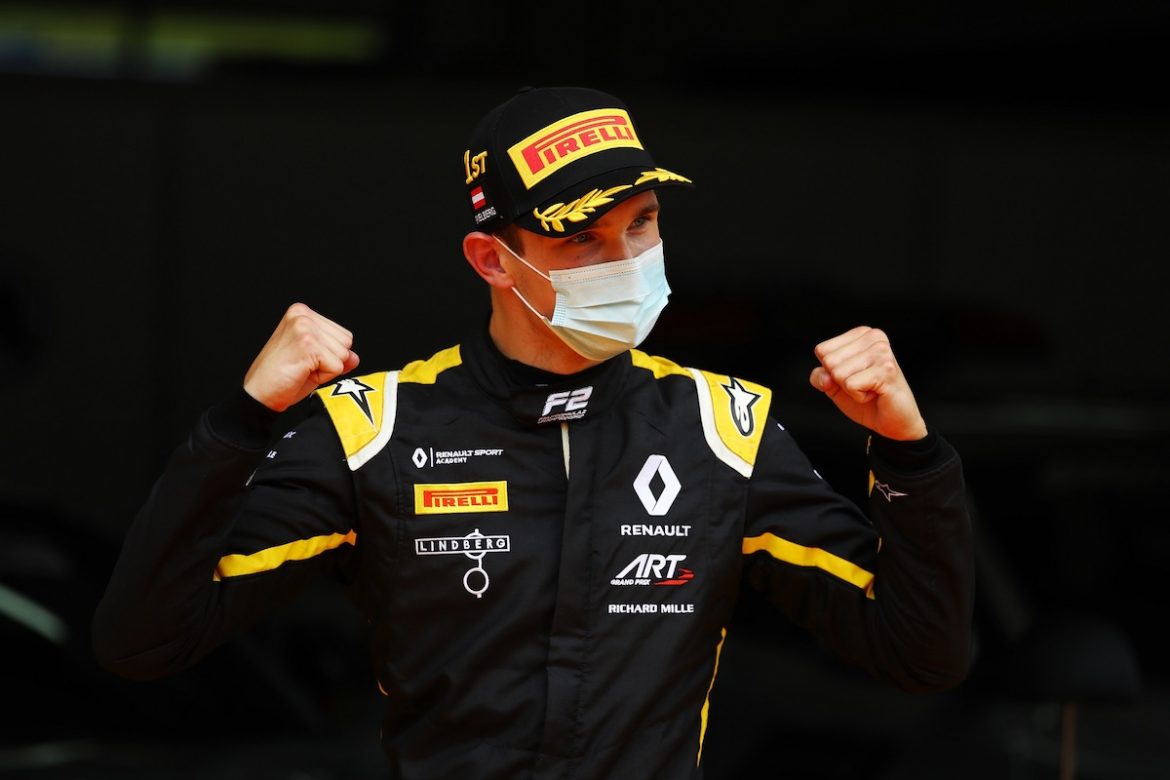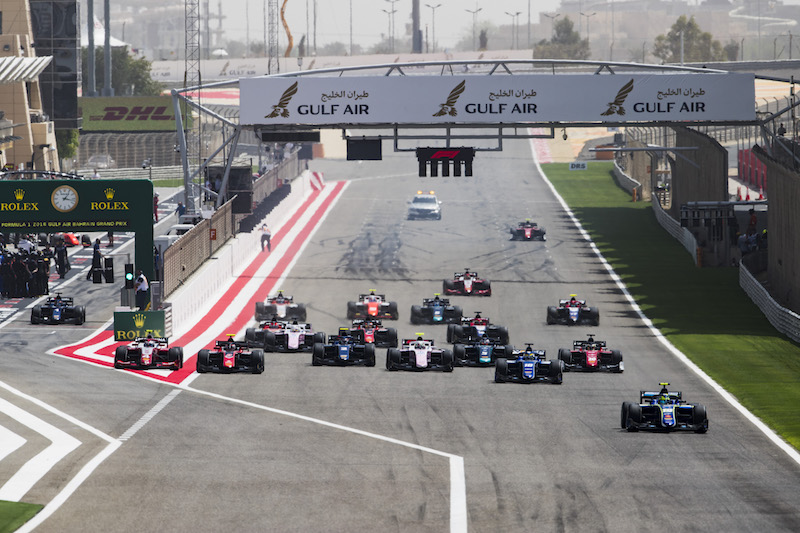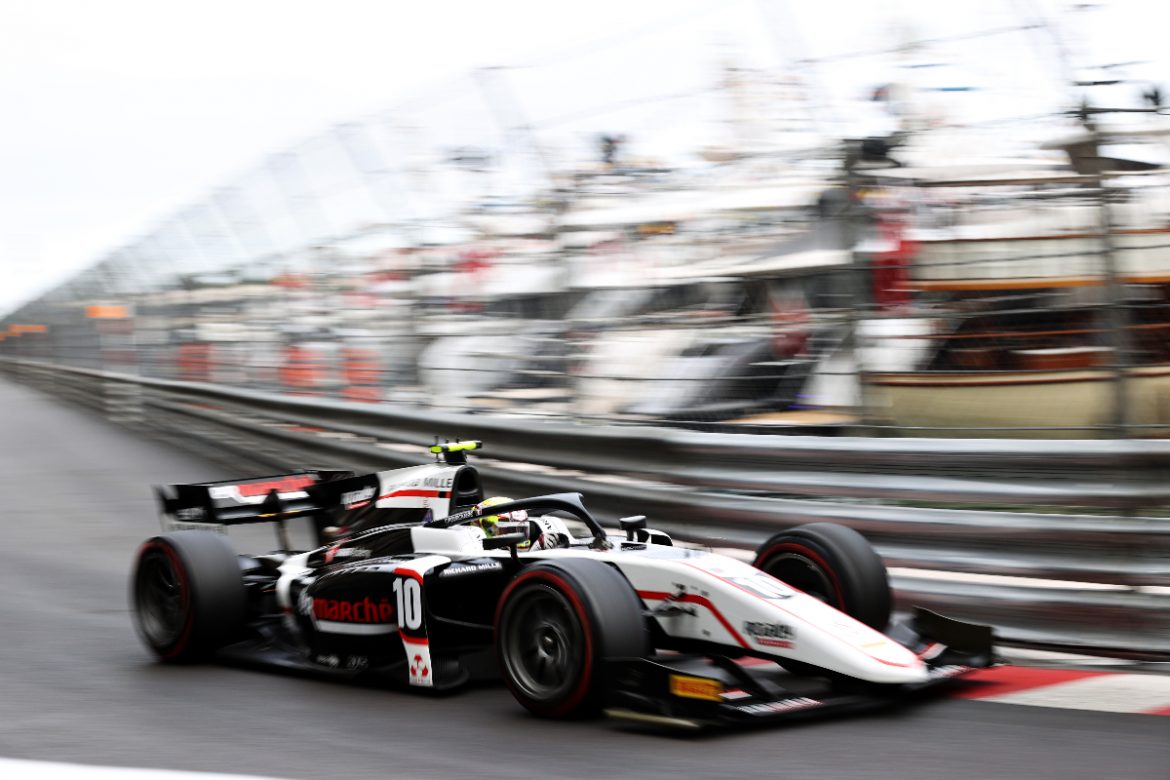
Photos: Formula Motorsport Limited
Theo Pourchaire is now the youngest ever winner of a Formula 2 race at 17 years old, but who else joins him in the pantheon of teenaged winners in Formula 1’s primary feeder and support series?
In the 55 seasons that a secondary tier of single-seater racing in Europe has existed with the primary focus of sending drivers to Formula 1, there has been surprisingly few teenaged winners of races.
There were actually teenagers racing in F1 prior to the creation of the European Formula 2 championship in 1967, and many of the ones that have reached the pinnacle of motorsport in the years since have gone on to great success.
At first European F2 actually catered for F1 drivers too, with the stars of the day flitting between the world championship and then racking up results (but by no means easily) against the rising stars of the day. In fact it was more popular initially to go to F1 first and then develop your abilities further in F2.
That championship lasted until 1984, when shrinking entry lists led to the series closing down and the FIA creating what would eventually be named International Formula 3000 to replace it in 1985. A similar fate befell that too, with F3000 being shut down in 2004 after several years of pressure from F1 supremo Bernie Ecclestone and GP2 – created in co-operation with Renault F1 team principal Flavio Briatore and Bruno Michel – launched in its place.
GP2 technically ran through to the end of 2017, with a rebrand to the F2 name for its final season before it actually became a new championship recognised by the FIA in 2018 and introduced the Dallara F2 2018 car it still races with today. That vehicle has ended up being driven by a lot of young prospects, several who feature on this list of the youngest ever to win in the history of F1’s primary feeder series.
This discludes GP2 Asia, where Sergio Perez and Luiz Razia won aged 19, and all non-championship races.
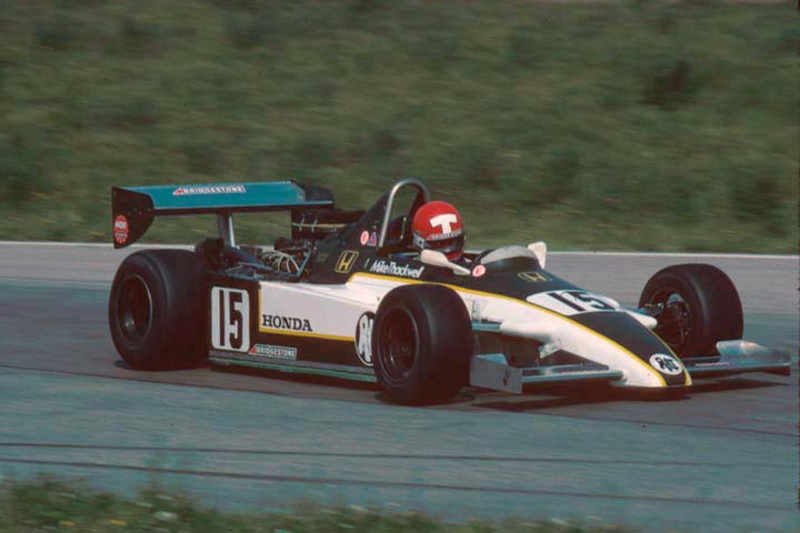 Not quite making the list but certainly making a mark on racing history are six drivers who all won in European F2/Int. F3000/GP2/F2 when they had yet to reach their 20th birthdays.
Not quite making the list but certainly making a mark on racing history are six drivers who all won in European F2/Int. F3000/GP2/F2 when they had yet to reach their 20th birthdays.
Doing that by just one day was elusive junior single-seater racing legend Mike Thackwell, who at the time of his first win in the second tier was already the youngest ever person to race in F1. His 1980 Canadian Grand Prix start took four years to follow up on, but between those appearances he established himself as a European F2 star. Thackwell’s first win came in the prestigious BRDC International Trophy race at Silverstone that opened the 1981 season, and he won it as a factory Ralt driver.
Nine days younger when he took his first F2 win was fellow Antipodean Oscar Piastri, who triumphed on just his second start at Bahrain back in March.
Fizzling with teenaged promise but then failing to truly deliver on that in GP2 and F1 were Sergey Sirotkin and Esteban Gutierrez, while Javier Villa‘s name was briefly on F1’s lips after a breakthrough GP2 win at Magny-Cours in 2007 but his later career took him to roofed machinery.
Similarly, Rafaele Marciello drove superbly in the series and he won in his rookie season in 2014 but a combination of being at the wrong place at the wrong time and Ferrari politics meant he never had an F1 career and instead became a sportscar great and GT World Challenge Europe champion with Mercedes-Benz.
Tarso Marques BRAZIL 19 years, 8 months & 5 days
1995 Estoril
Best known for somehow beating Minardi team-mate Fernando Alonso in the 2001 F1 standings, Marques was one of many Brazilians to test their racing fortunes with European teams in the late 1990s with ambitious steps up the single-seater ladder.
In two years he went from the small cars of Formula Chevrolet Brazil to the F1-style Reynard-Cosworth of Int. F3000, with zero success outside of his home country before his upwards move, but actually embedded himself well in Europe.
That integration into a new racing environment brought him level with his more talented peers, and while his rookie F3000 season with Vortex Motorsport aged 18 was difficult he actually came an impressive 12th in the points with a fastest lap to his name and a fourth place at Magny-Cours.
Admittedly there wasn’t standout names finishing behind him, but neither was anyone expecting him to perform that well.
Marques moved to DAMS for his second season, and improved to fifth in the standings despite scoring in only three of eight rounds. He started the year with fastest lap at Silverstone, followed by a maiden podium at Barcelona and then a surprise pole in Pau.
That breakthrough lasted about 220 metres in the grand prix before a violent and painful crash with fellow front-row man and team-mate Guillaume Gomez. That dissapointment was followed by two more retirements, but Marques did rebound.
At Spa-Francorchamps he finished fifth, then he took pole by over half a second at Estoril. The race was his too, and the 19-year-old lapped all but the top eight as he drove to what would be his biggest and last single-seater win.
In 1996 he moved up to F1 briefly with Minardi, coming fourth in the final ever non-championship event, then returned to the Italian team in 1997 and 2001, with IndyCar spells in between. His next racing podium was a Stock Car Brasil win in 2006.
Sebastien Buemi SWITZERLAND 19 years, 7 months & 22 days
2008 Magny-Cours sprint race
It was fortitious, but ultimately it’s unlikely Buemi would ever have got to F1 was it not for his 21st to first charge at Magny-Cours halfway through a GP2 season where his driving was coming under scrutiny.
The Arden driver, who had basically a full season of GP2 experience after a half-season in 2007 and an early 2008 GP2 Asia campaign, already had two sprint race podiums to his name but both had come from starting near the front.
At Magny-Cours he qualified fifth but that became a penalised ninth on the grid, and used an undercut strategy in the feature race to try to get a strong result. That ended in retirement, and left him 21st on the sprint race grid.
A damp track from pre-race rain added an extra variable to allow Buemi to recover, and with nothing to lose he opted to start the race on slick tyres while many at the front started on the full wet compound.
The wet tyre runners made stronger starts, but a dry line emerged quick enough to send much of the front half of the field into the pits to change – perhaps too late. Others lost it on their own on a tricky track surface, or clattered into one another.
Buemi’s team-mate Yelmer Buurman also made the right tyre choice from the off, although he got to start considerably higher up the grid, while iSport’s Bruno Senna was charging up from 23rd place before he encountered technical issues.
The victory battle came down to a straight fight between Arden’s drivers once the pitstops had played out, and it took a whole lap of side-by-side action for Buemi to successfully pass Buurman. He pulled away at a second per lap after achieving that to take a 6.639s win, with the rest of the field over 20s behind.
Buemi won another sprint race in 2008, then got his F1 calling with a Toro Rosso team impressed by his technical ability.
Charles Leclerc MONACO 19 years, 6 months & 0 days
2017 Bahrain sprint race
Leclerc came back from a mid-race pitstop to win the sprint race at the abrasive Bahrain circuit in 2017, immediately marking himself out in F2.
He was one of four drivers to make a pitstop during the race, expertly using the medium compound Pirellis to build a lead of 9.4s before moving onto softs to attack for the final nine laps of the race and making 13 overtakes.
Luca Ghiotto and Oliver Rowland completed the podium, 1.5 and 2.8 seconds behind the winner, after both being passed in the final two laps of the race and not having the grip to compete for the win.
Leclerc started in sixth, a position which effectively became fifth when polesitter Nobuharu Matsushita was forced to start in the pitlane with pre-race mechanical issues, but had a superb launch to move up to third on the first lap of 23.
He then passed Alex Albon at Turn 4 on lap four after an early safety car period when Norman Nato spun off with a puncture. Leclerc overtook early leader Ghiotto on lap nine, and went on to build his lead before the sensational post-pitstop fight to the front to counter the issues he was having with tyre life which ruined his chances of a win in the feature.
Eddie Cheever USA 19 years, 5 months & 16 days
1977 Rouen-les-Essarts Grand Prix
Ron Dennis’s Project Four Racing team had factory BMW engines, top chassis from Ralt and a line-up consisting of a baby faced Cheever and former Fittipaldi F1 driver Ingo Hoffmann in 1977.
Hoffmann’s experience had nothing against the sheer ability of Cheever, who came second in the Jochen Rindt Trophy race at Thruxton early in the season after a frantic podium battle and then really made his name known in the famous Eifelrennen on the full 20.83-kilometre Nordschleife.
Although he qualified down the order on the daunting track, he was far more confident in the race and made his way to second place within two laps. The driver he was chasing for the win was 30-year-old Jochen Mass, already an established F1 name with McLaren.
Mass’s experience made him a ‘graded’ driver ineligible for points, and according to reports at the time Cheever used a mature head and decided to just sit in Mass’s mirrors for the remaining seven laps of the race. Mass did open the gap towards the end though, suggesting he had as much in reserve as Cheever did, but it was Cheever who took the points for victory.
It wasn’t until four rounds later at the fast, flowing and equally scary Rouen circuit in France that Cheever took his actual first win, following another podium at Vallelunga, but it was with just as mature a display as he’d shown in Germany.
This time it was keeping a cool head while others crashed that sent Cheever up the order after another lowly qualifying.
The first corners of the track were all downhill and didn’t require braking, meaning there was little time for drivers to react when on the opening lap the frontrunners slowed and those behind concertinaed down the Rouen hill.
Rene Arnoux and Patrick Tambay crashed immediately, and Cheever timed his approach to not only get through the chaos safely but move up the order and into victory contention. Once in the lead he kept a steady pace, but at the same time pulled away while more of his rivals faltered.
After 38 laps he finished 7.6s clear of Trivellato Racing’s Riccardo Patrese and Ecurie Elf’s Didier Pironi to become the first ever teenager to win at this level of single-seater racing. Cheever ended up as title runner-up that year, and stayed in F2 for another two seasons before establishing his presence in F1 and later becoming an IndyCar race-winner and team boss.
Sergio Sette Camara BRAZIL 19 years, 3 months & 4 days
2017 Spa-Francorchamps sprint race
A fast start earned Sette Camara his first car racing win at Spa in 2017, as Leclerc came from 19th on the grid to finish fifth.
MP Motorsport driver Sette Camara ended Saturday’s feature race set for reversed grid pole for the sprint, but the exclusion of Leclerc and Oliver Rowland promoted him to sixth and put him third on the sprint race grid behind Nato and Roberto Merhi.
He almost immediately took the lead however, shooting between the top two after a superb getaway. Fellow second-row starter Nyck de Vries dived to the inside of Nato at La Source, and completed the move into Les Combes.
Sette Camara soon built a one-second margin over de Vries, and had doubled that before the safety car came out on lap 15 of 18 after a huge shunt for Nobuharu Matsushita at Raidillon.
The clean-up was almost completed in time for one final lap of racing, but Sette Camara ultimately did not have to worry about a restart. From the rear of the grid Leclerc got up to 14th on the first lap, was in eighth by lap six, and finished in fifth.
Liam Lawson NEW ZEALAND 19 years, 1 month & 16 days
2021 Bahrain sprint race 1
Lawson fended off fellow Red Bull junior Jehan Daruvala to win the opening reversed-grid race of the 2021 season at Bahrain.
He went from third to first on the run down to Turn 1 on the opening lap, passing reversed grid polesitter Theo Pourchaire and David Beckmann.
Lawson set the fastest lap on lap two to build an early race lead, while Pourchaire and Beckmann squabbled for second. Pourchaire emerged in front and he held that position until his ART Grand Prix-run car ground to a halt with 10 laps to go.
Daruvala dispatched Beckmann around the outside of Turn 4 at the halfway stage in the race and closed in on Lawson but couldn’t find a way past the Kiwi. In the proccess, Lawson became just the 13th driver ever to win on their first F2/F3000/GP2/F2 series start, after Jochen Rindt, Dave Morgan, Gerard Larrousse, Stefan Bellof, Johnny Herbert, Jordi Gene, Ricardo Rosset, Stephane Sarrazin, Heikki Kovalainen, Alvaro Parente, Charles Pic and Stoffel Vandoorne.
Fernando Alonso SPAIN 19 years, 0 months & 28 days
2000 Spa-Francorchamps
Alonso had already won six races and the title in Formula Open by Nissan in 1999, which would evolve into the GP2-rivalling Formula Renault 3.5 series, and so had already proven himself at this level when he moved to Int. F3000 for 2000.
He joined Belgian team Astromega, a proven outfit over the previous years, but his season didn’t get off to a strong start with a spin on the way to ninth in his first race at Imola, then a non-compliant engine mounting got him excluded from the next round at Silverstone after qualifying sixth.
After that was his home race at Barcelona, but on the second lap he collided with Sebastien Bourdais and spun down from 13th to 22nd, then in his recovery drive collided with Kristian Kolby and spun again, eventually finishing 15th.
A multi-car crash wiped him out on lap one at the Nurburgring, but he had reason to smile as two days later he was announced as a Minardi F1 test driver.
Next up on the calendar was Monaco. From 13th on the grid there he was never going to score highly, and he had his race compromised when Darren Manning crashed ahead of him. But he was consistently showing strong race pace, and high attrition led to an eighth place finish alongside taking the fastest lap.
At Magny-Cours he qualified third, and was then running fifth before a fuel pump failure sent him into retirement and down to 21st in the standings. Two weeks later at the A1 Ring (now the Red Bull Ring), he qualified 15th but charged up the order in the first half of the race and earned his first point in sixth place.
He hadn’t quite unlocked good luck yet though, with another retirement at Hockenheim meaning he was still 21st in the points with two races to go. The penultimate round was at the Hungaroring, and after qualifying third Alonso pressured Bruno Junqueira all the way for the win but came 0.595s short.
There was just one more chance for Alonso to break his victory duck, and he made the most of it. The Spaniard took pole for the Spa season finale, then dominated the race and took fastest lap to end the season fourth in the standings.
Christian Lundgaard DENMARK 18 years, 11 months & 20 days
2020 Red Bull Ring sprint race 2
After two rounds of the 2021 season, Alpine junior Lundgaard is yet to score the same amount of points as he earned with his first win in 2020, taking victory in the support race to the Styrian Grand Prix.
In the previous day’s rain-soaked feature race he had worked his way through the field before a mistake at Turn 6 blunted a potential podium charge.
He started the sprint race from third on the grid and passed ART Grand Prix team-mate Marcus Armstrong for second at Turn 1 on the opening lap. A virtual safety car period meant Lundgaard had to wait to race for the lead, but he wasted little time following the restart, and dived down the inside of polesitter Dan Ticktum at Turn 3 on the second lap after the restart.
FIA Formula 3 Championship graduate Lundgaard fired in two successive fastest laps to build an advantage over Ticktum in excess of the one second needed to escape DRS range. From then on he maintained a gap of around two seconds to win.
It was a particularly impressive display by the rookie as he has missed the pre-season test at Bahrain due to being in quarantine brought about by the COVID-19 pandemic, and the lockdown period limited his access to ART GP too to learn the car with a model of the new-for-2020 18-inch tyres on the team’s simulator. But over the opening two rounds at the Red Bull Ring he had the second best race pace behind Ticktum, and had a clear peak pace advantage over long runs.
Lando Norris ENGLAND 18 years, 4 months & 25 days
2018 Bahrain feature race
Standing in at the struggling Campos Racing team at the 2017 season finale meant when Norris lined up on pole for 2018’s first race he didn’t have the opportunity to become a winning debutant, but he did become the first to win in F2’s current car.
The Carlin driver dominated the Bahrain season opener, while Artem Markelov charged through to third from a pitlane start.
A stall on the warm-up lap for Markelov meant the Russian Time driver started from the pits, while Norris led the field away and pulled out a lead of nine seconds within the first nine laps.
A troublesome pitstop cut that lead down, but we built the advantage back up to 8.321 seconds by the chequered flag, with team-mate Sette Camara completing a Carlin one-two on the team’s series return.
He earned that spot after a spectacular late battle with Markelov who extended his first stint longer than anyone else, jumped up the order with the overcut strategy and then had a tyre life advantage late on.
While Norris broke the race-winner age record, sat at the top of the standings for half of the season and earned a McLaren F1 seat for 2019, he didn’t actually visit the podium’s top step again in F2 and lost the title to ART GP’s George Russell.
Theo Pourchaire FRANCE 17 years, 9 months & 2 days
2021 Monaco feature race
Formula Scout discussed with Pourchaire at the start of 2021 that he potentially had a record-breaking year ahead of him, but the French 17-year-old wasn’t particularly interested in the stats. That changed somewhat last weekend.
From pole he expertly controlled the Monaco feature race, only dropping out of the lead during the pitstop phase.
His only challenge for the win came early on when Robert Shwartzman put him under pressure, but it wasn’t long before Pourchire managed to shake off the Prema driver and extend a gap to the rest of the field.
That then extended further when a problem during Shwartzman’s pitstop dropped him out of contention for the lead.
The second half of the race was riddled with VSC periods, but Pourchaire edged out a gap while green flags were waved to finish 2.894s ahead of Prema’s Piastri.
“It was amazing, the race was so stressful because I was under pressure,” Pourchaire said after victory.
“Monaco is unique, you cannot make a mistake in Monaco, so I was so concentrated. We had the perfect race; I was fast in the second part of the race and we had a really good strategy.”
The feature race performance capped off a weekend that began with Pourchaire becoming the youngest ever polesitter not only in F1’s primary support series but the whole of single-seater racing’s second tier of competition. He beat the benchmark set by Alonso at Jarama during his title-winning FOpen by Nissan season by 17 days.
More classic GP2/F2
Kanonloppet 1973: The last time F2 held a three-race weekend
The F2 winners who started further back than Matsushita
Junior series in Monaco: From the sublime to the ridiculous
How to make the fastest junior single-seater in the world
Reliving the first ever GP2 weekend: Imola 2005
The strange story of the support series that supported itself
Top 10 GP2 drivers that F1 missed out on
Giacomo Ricci: The GP2 underdog leading F2’s dark horse



